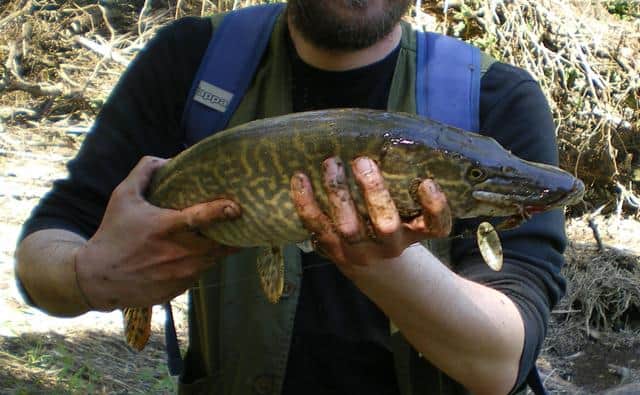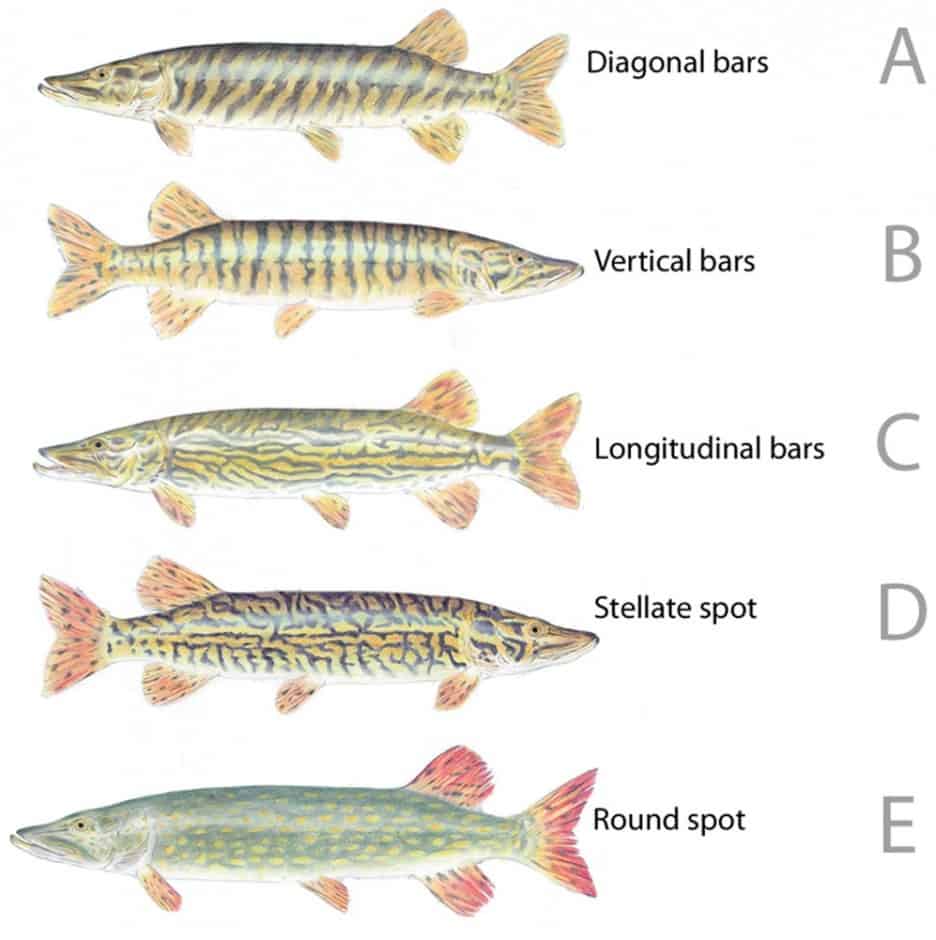If you’re a pike angler based out of North America this can look like a joke of a question. I had never even heard of a Southern Pike until a few weeks ago, and at first assumed it was a weird local dialect for chain pickerel, the main pike look-alike in North America.
Figuring out the differences between the common northern pike (which can also be found throughout Europe) and the southern pike is difficult, and there are reasons for that.
The southern pike is a closely related cousin to the northern pike that is found only in Europe. They weren’t considered a separate member of the Essox family until 2011, which shows how closely related to northern pike they are.
In fact, it took an in-depth study by biologists to figure out that the southern pike wasn’t just a northern pike with slightly different colors, but that it had changed enough over time to be considered its own species.
And therefore the newest member of the Essox family.
Northern Pike Vs. Southern Pike: A European Question
This isn’t going to be your normal comparison article looking at two fish and being able to clearly show the similarities and differences. Considering the southern pike wasn’t even recognized as separate species until 2011 (you can see the summary of the research paper arguing for a new pike species HERE), there hasn’t been a lot of research comparing and contrasting the two.
The overwhelming majority of southern pike are found in Italy. There are some reports that small populations might be in the southernmost Alps of Switzerland or in the edge of the Balkans, but for the most part this is an Italian Pike (and that is likely to be a nickname that eventually sticks).
Southern pike are unusual in that they have four different patterns compared to the northern pike’s one.
| Northern Pike | Southern Pike | |
|---|---|---|
| Name and pic |  |  |
| Scientific name | Esox lucius | Esox cisalpinus |
| Habitat | Northern latitudes throughout North America, Europe, and Russia | Mostly Italy, some isolated potential populations in southern Switzerland and Balkans. |
| General Description | Hard fighting, aggressive freshwater fish known for sharp rows of teeth, distinctive side pattern, and green coloration, as well as large size. | Very similar to the northern pike, known as hard fighting aggressive pike found throughout Italy with four different patterns. |
| World Record* | 55 lbs. | 22 lbs. |
In many ways the southern pike are going to look and act like northern pike, and they are still in the Esox family, having originally been the same type of fish as northern pike before breaking off and evolving over time.
While the unofficial southern pike record is 22 lbs, there’s no reason in the right environments that these pike couldn’t reach roughly the same size as their northern pike cousins in the same area.
There’s sure to be more research on this because as two separate species there’s a danger of hybridization if northern pike and southern pike are put in the same water. The problem with hybrids is that hybrids are generally sterile in nature.
If a growing population of fish can’t have offspring, then that could be threatening to both populations of fish in those waters especially over the long run.
Because of that this distinction is quite important, especially in pike-stocked Italian waters.

Why Haven’t I Heard of a Southern Pike?
The most obvious reason is that as of this blog post the officially recognized southern pike is only 9 years old! What does that mean?
Up until 2011 the southern pike wasn’t considered its own species. This was just considered a “slight variant” of the northern pike that was found in Europe. There really wasn’t a reason to challenge this for a long time.
The signs were there of a different fish. Different side patterns, different habitat, but many of the aggressive behaviors were there.
Southern Pike Are a European Fish
As discussed a little bit above, the other reason could be because the habitat of where you can find the popular southern pike is very limited. Not only is this a European pike, but the new one is focused almost entirely in Italy along with possible small populations in the southernmost section of Switzerland and the outer/coastal Balkans.
Because of that, many anglers didn’t hear about this change at all.
Unless your fishing adventures take you through Italy, why would you? However that does make things interesting for anglers looking to catch every type of Esox or every member of the pike family.
Generally E in the chart below will look familiar because you know a northern pike when you see one. However A-D whose patterns vary from musky-like to pickerel-like, these are all common designs that you will find when looking at various southern pike.

Southern Pike: Biological Vs. Fisherman
For the most part this hasn’t been a big change to anglers in the area. If you were going pike fishing throughout Italy, you were likely going after the now recognized southern pike regardless of what the name was prior to 2011.
The reason the southern pike is recognized is a new fish is because there are enough differences in genetics and morphology to let biologists know that hey, this wasn’t a northern pike, this was different enough to be considered a separate fish.
So among anglers there is no practical change, per se.
However when it comes to managing the stocking of these popular sports fish throughout Italy this is a very important distinction. While a hybrid can be a neat not-so-little catch, their inability to reproduce can hurt the numbers of pike in an area over time.
However, this does make future studies on southern pike more interesting. When will they be recognized with official sports angling records? How clear will several populations become, especially outside of Italy?
Something worth keeping an eye on, especially if you’re really interested on the differences between northern pike and southern pike.
This is the most current picture of the largest confirmed southern pike (so aka Italian Pike world record).

Northern Pike Vs. Chain Pickerel
If the north pike vs. a south pike question is U.S. based and referring to the related Esox of the chain pickerel, then there are some obvious differences. We won’t spend too much time on this as we’ve already talked about telling pike and pickerel apart extensively in another blog post.
The chain pickerel are the fish in the United States most often mistaken for a small, smallish, or medium sized pike. They are not a southern pike, but they are the often southern located Esox cousin to the pike.
The Bullet Point List for Pike vs. Pickerel Differences
- Teardrop pattern underneath the eye (narrow vertical for pike, wide angled for pickerel)
- Size – all fish above 10 lbs are pretty much pike
- Side pattern
- Spots on the fins mean pike
- Coloration differences (yellow vs green)
- Sets of pores under the jaw
If the pickerel was what people were mistakenly calling southern pike, then it won’t take too long to tell them apart in most circumstances. Even the hybrids can be correctly identified if you know what to look for in each of the two base species.
You can also check out this pretty good side by side illustration courtesy of the state government of Maine.
Southern Pike FAQ
Q: Is the southern pike that much different from the northern pike?
A: From an angler’s standpoint there really isn’t going go be much of a difference. If you were pike fishing throughout Europe before 2011 and after 2011 it’s not like you noticed a difference just because of the different speciation.
From the point of view of a biologist or those responsible for stocking fish this is crucial because intermixing northern pike and southern pike could result in hybrids in the wild, which can damage the long-term health of both fish since hybrids can’t reproduce naturally.
Q: How much do we actually know about the Southern Pike?
A: This is one of those answers that’s going to sound like a contradiction, but it’s “A lot, and not a lot.” Because the separate species has only recently been recognized, there’s a ton of overlap with northern pike caught in Italy and those that would now be considered under the new designation of a southern pike.
Because of this various numbers and information on the species can vary immensely over
Q: Just how big do northern pike, European pike, or southern pike get?
A: Depending on which pike and the location the numbers can vary. You’re generally hitting world record levels of northern pike at around 40 lbs in North America, up to 50 lbs in Europe and Russia, and a bit above 20 lbs for southern pike – although this last number is expected to change a lot over time as more attention is paid to southern pike as a distinctive separate species.
Q: What is the biggest difference between the various southern pike designs versus northern pike design.
A: Southern pike tend to have various lines and patterns which can run both horizontally and vertically. On the other side of things the northern pike’s designs will be distinctive spots versus lines and the pattern will run left to right horizontally as opposed to vertical lines going up and down.
Q: What gave away the idea that southern pike and northern pike were different species?
A: The number of scales along the lateral line is very different between the two species. Northern pike’s range for these scales along that line is 125 to 148 while the southern pike ranges from 101 to 115.
Q: Are southern pike ever displaying the same dotted pattern as northern pikes?
A: Nope. That dotted pattern is only for northern pike, southern pike will not have that distinctive pattern.
In Conclusion
The upcoming years will be interesting to see if anglers or various local fishing guides put more information out on the Southern Pike. In many places there isn’t a noticeable discernment of one from another, as local fisherman just call it “pike fishing.”
After all, if they’ve spend decades fishing for local pike, what do they care if some of them have a slightly different name now? Same fight, same delicious taste, same fun time out on the water.
A good pike is a good pike whether it’s the northern pike found throughout northern climates in the world or the southern pike found in Italy and a limited range of locations in Europe.
While this is a very interesting comparison between the two species, basically pike fishing is great wherever in the world you decide to enjoy it.
